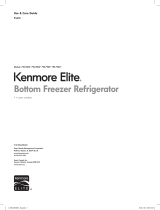
4
IMPORTANT SAFETY INSTRUCTIONS
When using electrical appliances, basic
safety precautions should always be
followed to reduce the risk of fire,
electrical shock, and/or injury to
persons, including the following:
Read all instructions before using the appliance.
This appliance must be grounded. Connect only to properly grounded outlet.
See Important Grounding Instructions on page 3.
Install or locate this refrigerator only in accordance with the provided
Instructions.
Installation
To protect against electric shock do not place cord, plug or refrigerator in
or other liquid.
, , water
Close supervision is necessary when any appliance is used by or near children.
Do not operate this appliance if it has a damaged cord or plug, if it is not
properly, or if it has been damaged or dropped.
working
This appliance should be serviced only by qualified service personnel. Contact
your nearest authorized service facility or call our toll-free customer service
number for information on examination, repair, or adjustment.
Do not cover or block any openings or air vents on this appliance.
Do not store this appliance outdoors. Do not use this appliance near
water. For example, do not use near a kitchen sink, in a wet basement,
near a swimming pool, or similar locations.
Do not locate this appliance near heat sources or open flames.
Do not use or store gasoline or other flammable vapors and liquids in the
of this or any other appliance. The fumes can create a fire hazard or explosion.
vicinity
Do not place heavy objects or magnet items on top of the refrigerator.
The refrigerant of this product is R600a, which is flammable. Make sure
damage the cooling system during the transportation and installation.
not to
To minimize the risk of possible ignition due to improper service or the
incorrect parts, this unit must be serviced by factory authorized personnel only.
use of
!!SAVE THESE INSTRUCTIONS!!
WARNINGWARNING
DANGER! RISK OF CHILD ENTRAPMENT
Before you throw away your old refrigerator or
freezer
1) Take off the doors.
2) Leave the shelves in place so that children may not easily climb inside.
All refrigeration products contain refrigerants, which under federal law must
be removed prior to product disposal. If you are getting rid of an old
refrigeration product, check with a qualified disposal company for instructions.
Refrigerants




















